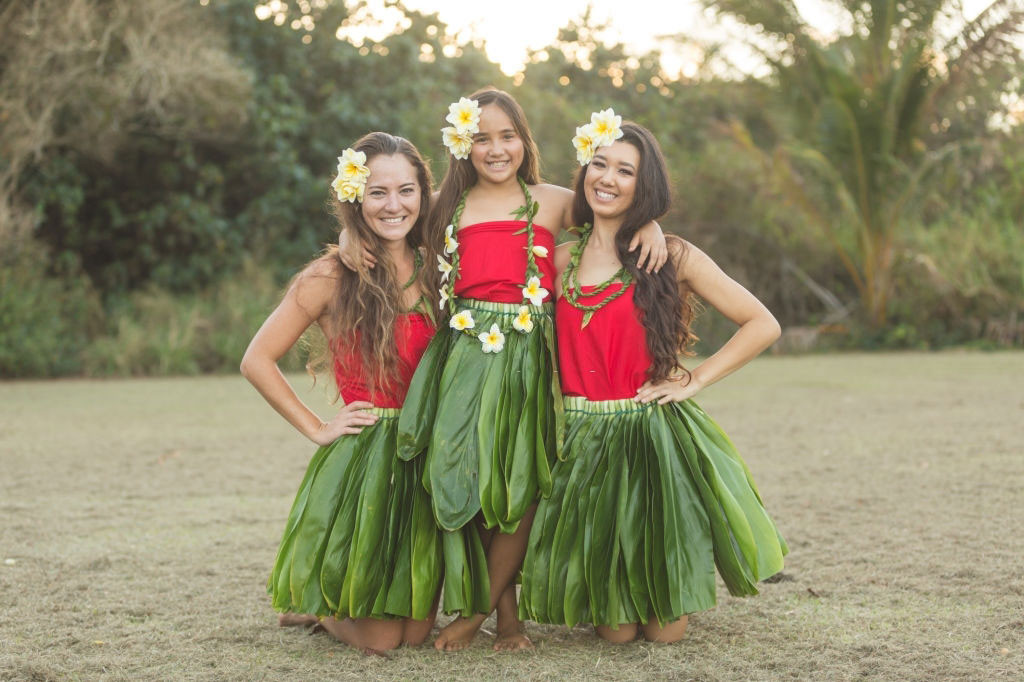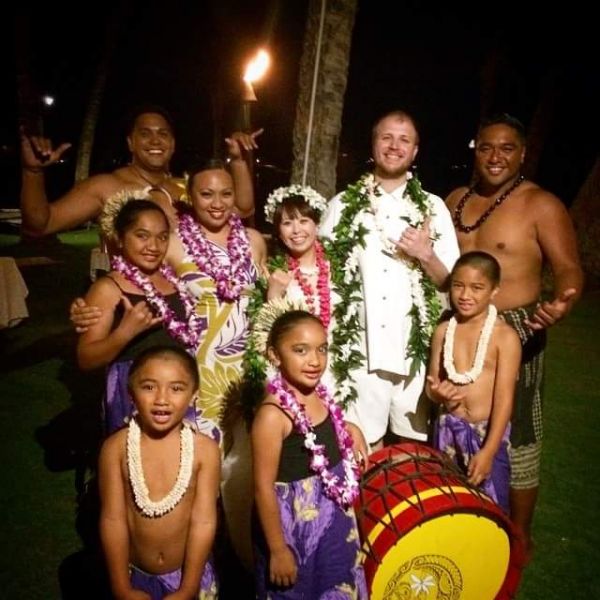Traditional Hula Costumes are typically made up of a ‘pa’u’ (a skirt) and a pā’ū mālō (a blouse), which are sometimes accompanied by other items such as an ʻahu ʻai (skirt cover), or lei, maile vines, or coconut leaves used for decoration. The pa’u may be made from any number of materials including tapa cloths in different colors, silk designs like kapa haka that often had floral patterns on them, cotton prints, hand-woven fabrics called lauhala mats which could have been dyed to produce reds and blacks during the time of King Kalākaua, and even suits of armor.
Pa’u’
The traditional Hawaiian ‘pa’u’ (a skirt) is common for the traditional Hawaiian ‘pa’u’ (a skirt) is common for both men and women. It was originally worn as a loincloth of sorts, but eventually evolved into the decorative garment it is today
The pāʻū ma ōlō (blouse) follows the shape of an inverted triangle with one point at the top, and is often made with lace or a similar fabric. The shape of this garment can vary from simple to fanciful depending on its use in hula costume, lua (a traditional Hawaiian martial art), or as evening wear.
Traditional Hula Costumes: In recent years there has been an increase in demand for more modest clothing options that allow female dancers to participate fully in school sports like volleyball while wearing their cultural attire. There are many designs available now which reflect these needs by being less revealing than the original pāʻū ma ōlō . These usually provide enough coverage to be worn comfortably without risking injury during physical activity, but still show off some skin so they appear feminine and attractive while maintaining modesty.
GRASS SKIRTS
Hula Dancers traditionally wear accessories such as Hawaiian grass skirts in modern Hula because it was originally made of blades of the native ti plant which were woven together in one long strip and then rolled up into an elasticized cylinder before being sewn at each end to form a tube. The smooth rolling motion that dancers used when wiggling their hips provided kinetic energy when music would tell the story of performance. Instruments would accent the dance, and sometimes men wore aloha hula skirts in Hawaii.
The art of Grass skirts in Hula began in the 19th century when missionaries introduced skirts made of grass to hula dancers. At first, these skirts were made for young girls and women who danced in churches as part of Sunday services or other Christian ceremonies.
Today, traditional Hawaiian costumes are not just limited to Grass Skirts but also include Aloha Shirts and Lei Necklaces, along with the modern luau with leis, bracelets and dance to tell stories through songs in a unqiue Polynesian way. The rhythm of dance is a celebration of life in the islands and links the male and female performers back to their ancestors. Dance has been a tradition for a long time.

KUPE E
Kupe e is a traditional hula costume worn by both males and females. Kupe e comes in many different colors, shapes and sizes to suit the wearer’s particular needs or desires. The traditional kupe e is made of a malo (loin cloth) draped over the shoulders with tapa strips wrapping around from one side to the other.
HULA AUANA
Hula auana is a dance in Hawaii that is made up of four parts: the traditional hula dance, which is based on ancient Hawaiian hula; haka, which originated in New Zealand and is a kind of war chant or challenge; oli (or mele), unaccompanied song without rhythmic accompaniment for celebration or mourning.
The traditional hula costume for the female dancer to Hawaii music is a holoku. This is made up of three different parts: one-piece, short kilt that covers from waist to midthigh; pareu (a wraparound skirt), which hangs down below and can be worn in various styles or wrapped around hips instead of thighs;
Traditional hula costumes used in dance can vary in style depending on the type of dance that you will be performing as well as the island that your ancestors are from. For example, a kahiko costume is typically more traditional than an `ahu ʻai or modernized pa’u skirt because it goes back to pre-1700s Hawaii when there was no clothing worn below waist level. There were two general styles for Kahiko: outrigger (pa’u) dancing with skirts made from malo bark cloth; and standing postures where dancers wore skirts made of tapa cloth while using their hands to represent paddles at dances such as Hooponopono and Pokala.
The `ahu ʻai is a more modernized Polynesian traditional hula costume with the skirt made from an artificial grass called pili that were mixed in different colors to produce black, reds and greens. The Wa’a kaulua was another type of standing position where dancers wore skirts made out of tapa cloth while using their hands to represent paddles at dances such as Hooponopono and Pokala. These costumes are typically seen when there are hula competitions or performances for tourists on cruise ships. Modernized pa’u skirts can also be worn by women who have not danced since they were children because it is easier than wearing Kahiko which require knowledge about ancient Hawaiian culture, traditional steps, and the significance of certain movements.
Traditional hula costumes are typically made out of a traditional fabric called `ahu ʻai which is a sinewy barkcloth that is stitched together with coconut fibers in an intricate process which can take hours to complete depending on how elaborate it needs to be. The skirt part known as pa’u was originally worn by men but over time they became more common for women who wanted their own kind of dress rather than wearing Kapa cloths like men did at different times throughout Hawaiian history because the skirts were felt subtler and easier to store given where people lived back then. One example would have been along side villages near large bodies of water or beaches because this allowed them easy access to water for catching fish and crabs.
Hulas originated in Polynesia where they were an expression of worship or thanks to their gods. They also served as entertainment for royalty, chiefs and often times included fireside chats about religion and other important topics.
In ancient Hawaiian culture, it was believed that women who wore pa’u would have better singing voices than those who did not. It is said that this led to more elaborate costumes with more fabric and detail.
Hula Kahiko
The Hula Kahiko is a Hawaiian dance style that uses traditional costumes. Hula Kahiko is based around the chants of Hawaii’s early immigrants called wahine (women) and kane (men).
Traditional hula costumes are typically made out of a single layer of cloth, known as pareau, with various colors to distinguish which type you belong too. A costume could be one color for women or something like black and white for men. The most common material in hula costumes today is cotton. It allows you to move more than other materials.
The headwear worn by both genders usually was a tiara-like crown that rested at the top center front part of their hair otherwise they wore some sort of hat either from pandanus leaves or coconut shells woven.
Hula ʻauana
Hula ʻauana is another traditional Hawaiian costume em. In traditional hula it is considered taboo for women to show their legs and upper body while in ʻauana, they are required to do so.
Traditional Hula Costumes
Hula costumes have been around since the 1800s when immigrants from Polynesia came over on ships after being forced out of their countries by missionaries. They brought with them religion and language as well as dance traditions that had evolved into what we now know as hula today. There was no written tradition then but memories were passed down orally between generations about how a costume should look like or be made up of at least until 1892 when David Kalakalapa wrote an account on all things Hawaiian including the history of traditional dress making originally called ‘kalauna.’

Traditional Hula Costumes For Women
The traditional hula costume is called the ‘ku’u poʻo,’ a skirt that can be as long or short depending on where it’s being danced. In ʻauana, which has more of a contemporary look to it with dresses and skirts paired with high-heeled shoes, women are encouraged to show their legs and upper body while in traditional hula costumes they’re required to do so. A kānaka maoli (Native Hawaiian) woman will traditionally wear her hair down no matter what type of dance she performs but if you have lighter skin, then there may be certain things about your appearance such as makeup or nail polish color that might not be appropriate.
Traditional Hula Costumes For Men
Men typically wear a loincloth, called the ‘pāʻū,’ with traditional hula costumes in order to cover their genitals while dancing but wearing one can be considered an insult to some dancers and therefore it’s not always seen on stage. There are different styles of pā’u including the ʻao (loose) and tihemaile which is tighter fitting so that there won’t be as much movement during the dance. A wahi kapa or kalaaua may also be worn over top if you’re at home watching your friends perform, though this will depend largely on what type of event you’re attending like a luau or church.

Merrie Monarch
Merrie Monarch in Hawaii is a week-long festival of hula and Hawaiian culture.
It is the largest cultural event in the state, as well as one of Hawaii’s most prestigious events.
The Festival includes performances by more than 100 hālau from across Hawaiʻi (the Islands), plus a variety of concerts, art exhibitions and workshops. The annual Merrie Monarch Festival pays tribute to the unique dance form of hula kahiko (ancient Hawaiian dance) and its continued relevance in modern-day life.
The annual festival is held each spring at the Hilo Civic Auditorium on Hawaii Island, with a two-night season finale event hosted by Maui Arts & Cultural Center Kahilu Theatre on Maui.
The Hilo Civic Auditorium was built in 1926 and has served as the traditional venue for Merrie Monarch since it began over 50 years ago. The auditorium is a state historic landmark, listed on the National Register of Historic Places (National Register #73000074). It is also an important part of Hawaii’s cultural heritage as the place where traditional hula was revitalized in modern times.
The Hilo Civic’s exterior features an eight-foot tall statue of King Kamehameha I, who united all of Hawaii’s islands under one rule and established a warrior dynasty that lasted for two centuries. The interior is equally majestic with its high ceilings, Spanish-influenced architecture, and original Hawaiian paintings.
The theater has a seating capacity of about 1750 and offers excellent acoustics for concerts, lectures, or plays. It was originally built as an opera house but is now used primarily for cultural events with most traditional hula competitions taking place on Maui instead.
Traditional hula costumes are often surprisingly simple in construction though they can be quite expensive to purchase commercially due the high demand for handcrafted items from artisans who often do not produce enough inventory to keep up with the demands of larger suppliers worldwide.”
Since it began over 50 years ago, Festival has been hosted at Hilo Civic Auditorium–a historic site that’s also featured prominently in Hawaii’s traditional hula costumes.
In traditional music hula, the costume is believed to tell the story to be an expression of a dancer’s personality and mood during performance. The most common colors for traditional hula costumes are red, black, yellow or white–with some variation in whimsy depending on the specific dance form. In Western culture, it is performed by twirling a hula hoop around the waist, using it as an extension of one’s torso.

